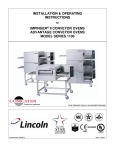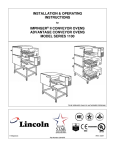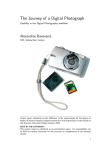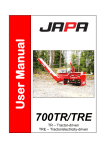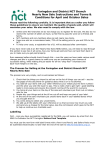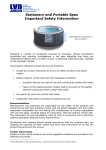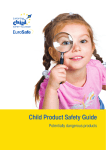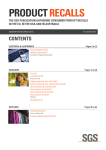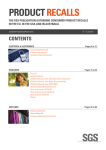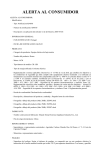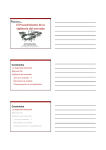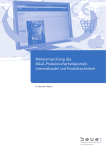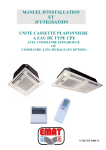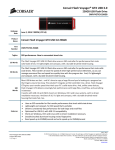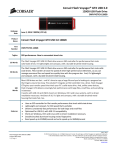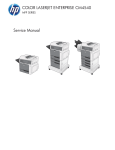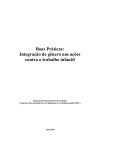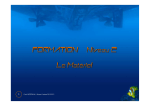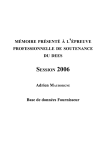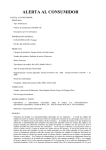Download 1.d.4.ii - 09-11-09 - Presentation
Transcript
Control of EEE products on the market © Dag Björklöf ASEAN-EU Programme for Regional Integration Support (APRIS) – Phase II Workshop 9-10 Nov. 2009 Dr. Dag Björklöf Asian Member States (AMS) take all necessary measures to ensure that regulated EEE (Electrical and Electronic Equipment) on the AMS market I: do not endanger the safety and health persons, or damage to property, must placed of when the equipment is correctly applied under normal use or reasonable foreseeable conditions of misuse Project funded by the European Union Implemented by IBF in consortium with CEN, Crown Agents and ACE Control of EEE products on the market © Dag Björklöf II: An EEE placed on the ASEAN market shall no cause damage or deteriorate the environment under reasonable conditions. III: The EEE shall be so constructed that the electromagnetic disturbances it generates / emission does not exceed a level that introduces intolerable electromagnetic disturbances, and shall have an adequate level of intrinsic immunity to electromagnetic disturbances to enable it to operate as intended. Control of EEE products on the market © Dag Björklöf Market Surveillance is a means for ensuring compliance with the AHEEERR and is considered an indispensable condition for effective application of the legislation Market Surveillance is also a means promote fair competition EEE producers / suppliers to among MS responsibilities Responsibilities © Dag Björklöf © Dag Björklöf MS Authorities are responsible to check / monitor Customs Authorities are responsible to check - that consumer products meet applicable requirements - that steps are taken to make products compliant - that sanctions are applied when necessary Post Market Surveillance Pre Market Surveillance the import of products from third countries Co-operation between MS and Customs Authorities is thereby a asset for preventing non-compliant products (products not fulfilling all legal requirements) entering the market place ! versus © Dag Björklöf Safety Liability vis-à-vis Safety © Dag Björklöf Product safety Post Market Surveillance (PMS) implies that MS Authorities are responsible to check / monitor products already placed on their market Pre Market Surveillance refers to controlling products before they are placed on the market, e.g. by supervision, inspection and certification - Rules to prevent accidents - Protection requirements must be fulfilled before a product is placed on the market Product liability - Rules for the liability when an accident has occurred or for damage caused by a defect product Post Post Market Market Surveillance Surveillance © Dag Björklöf To be able to monitor products placed on the market, PMS Authorities must have power, competence & resources: - to visit commercial and storage premises - to visit premises where products are put into service - to organise random and spot checks - to subject samples of products to examination and testing - to require necessary information Risk -based Market Surveillance Risk-based © Dag Björklöf For market surveillance to be efficient, resources should be concentrated where risks are likely to be higher or non-compliance more frequent, or where a particular interest can be identified. Statistics and risk assessment procedures can be used for this purpose. Control & Collaboration © Dag Björklöf National PMS Authorities primary function is to monitor that products placed on the market comply with the provisions of AHEEERR Subsequently, when necessary, the authorities shall take action to establish conformity Although market surveillance operations cannot take place during the design and product stages, efficient enforcement requires that MS Authorities act in collaboration with manufacturers and suppliers in order to prevent that non-compliant products are placed on the market. Market Surveillance vis -à-vis vis-à-vis Conformity Assessment © Dag Björklöf ‘The purpose of a harmonized Market Surveillance regime is to ensure that the provisions of applicable legal requirements requirements are complied with across the Community’ Community’ MS ≠ CA It is necessary to make a clear distinction between Conformity Assessment, before Assessment, which takes place the product is placed on the market and Market Surveillance, after Surveillance, which takes place the product has been placed on the market Product certification Conformity Assessment Bodies and Market Surveillance (MS) Authorities © Dag Björklöf © Dag Björklöf MS Authorities (Enforcement Bodies) • Designated to control that economic ..operators ..operators are fulfilling their obligations • State appointed public authorities Designated Laboratories Conformity • Independent of commercial interest Assessment Bodies (CABs) • Designated to assess conformity …with specified requirements • Work on behalf of suppliers …or other bodies/organizations • ProfitProfit-making Product certification is an activity by which a third party gives a written assurance that a product fulfils specified requirements. Assessment of the fulfillment of requirements in standards or other normative documents is one technique used to resolve any concerns that society has regarding products Certification schemes may be mandatory or voluntary depending on the intended market for the product. Mandatory certification is subject to enforcement by law. Voluntary certification schemes are undertaken by manufacturers to demonstrate correct quality - to gain market advantage. Product certification © Dag Björklöf Accreditation Dag Björklöf Product certification incorporates at least the following three functional stages: - Selection (sampling) - Review / Auditing - Determination & Attestation Product certification scheme Product certification scheme is a system related to specific products to which the same specified requirements, specific rules and procedures apply (Ref. ISO/IEC 17000:2004) Accreditation refers to the formal recognition by an Accreditation Body that a Certification Body / Conformity Assessment Body is competent to carry out certification / testing in specified sectors. Assessment © Dag Björklöf Dag Björklöf All activities related to the accreditation of a Certification Body / Conformity Assessment Body to determine whether it meets the requirements of relevant clauses of ISO/IEC Guides 61, 62, 65 and/or 66, or other recognised normative documents, necessary for granting accreditation, and whether they are effectively implemented, including documentation review, preparation and consideration of accreditation assessment reports and other relevant activities. Producer’s responsibility © Dag Björklöf For products manufactured in an AMS and branded by the manufacturer; all responsibilities for the product is on the producer. For products made in an AMS and branded by the distributor; the producer responsibilities should be shared between the manufacturer and the distributor. For products which have been reconditioned; the responsibilities of the manufacturer is overtaken by the person who reconditions the product. Producer ’s responsibility Producer’s responsibility The producer / supplier is responsible for fulfilling all essential safety and protection requirements according to AHEEERR, wherever the product is manufactured (ASIA, EU, USA…) The supplier has to ensure that a product complies with applicable requirements when placing the product on the internal market of the ASEAN community Responsibilities according to European practices © Dag Björklöf For products made outside the EU and branded by the manufacturer; manufacturer; the responsibilities of the producer is on the manufacturer’ manufacturer’s representative within EU. In case no authorized representative is appointed by the manufacturer, the responsibilities of producer should be on the company that imports the product into the EU (which may be the manufacturer’ manufacturer’s agent). In practice the importer will generally need to involve the manufacturer in any corrective action. For products made outside the EU and branded by the EU distributor; the responsibilities of the producer should be on the distributor. distributor. Malaysian Regulation Malaysian Electricity Regulation 97.1 (1994) No person shall manufacture, import, display, sell or advertise (a) any domestic equipment; (b) any equipment which is usually sold direct to the general public; or (c) any equipment which does not require special skills in its operation. unless the equipment is approved by the Commission. Producer Requirements IMPORTED PRODUCT Electrical equipments that have been approved for import into Malaysia Malaysia shall; • go through consignment test conducted by SIRIM .for every consignment within the validity of the CoA & • be affixed the label issued by SIRIM. MANUFACTURED PRODUCT Electrical equipments that have been approved for manufacturing shall; enlist with SIRIM’ SIRIM’s Product Certification Scheme, & be affixed the label issued by SIRIM. Manufacturer’s legal proceedings © Dag Björklöf Due Diligence © Dag Björklöf for marking A signed Declaration of Conformity (DoC) with reference to applicable directives (LVD, EMCD …) A technical file (technical documentation) A system to ensure compliance with the legislation (reasonable precautions) and a method to ensure that this system is followed correctly (”due diligence”) Example of factors relevant for a manufacturer to show that due diligence has been exercised Evidence of tests and checks undertaken Evidence that established procedures have been in place and followed Evidence of actions taken concerning eventual faults in the past © Dag Björklöf Offences Supplying non-conform equipment Quality as defined by ISO 9000: Taking into service non-conform equipment Production / distribution of misleading records Relevant instructions for use or eventual warnings .not in the official language of the country of use Failure to affix relevant marking on equipment .covered by applicable legislation Incorrect marking of equipment © Dag Björklöf PRODUCTS FROM CHINA IMPORTERS OF BANNED PRODUCTS NEW PRODUCT SIMILAR TO BANNED PRODUCT LACK OF RELEVANT MARKING Degree of which a set of inherent characteristic fulfils requirements The extent to which a product fulfils the expectations of the user / client The extent to which a product fulfils expected health, safety and protection levels Where / How to check products? © Dag Björklöf Supervision Supervision at the the manufacturer manufacturer’s premises at ’s premises Manufacturing control Surveillance Inspection Inspection when placing products on the market at the the user’s premises at user ’s premises or taking products into use PRODUCTS WITHOUT IDENTIFICATION Market surveillance surveillance Market Inspection of safety and health at retailers retailers or or wholesalers wholesalers or or at at trade trade fairs fairs or or at at workplaces at user user’s supplier’s premises when when appropriate appropriate at ’s && supplier ’s premises Approaches to market surveillance Market Surveillance © Dag Björklöf © Dag Björklöf Market surveillance may be performed Market Surveillance ofatconsumer at customs clearance points, importersproducts premises, in stocks, waresystematic houses & shops and atofexhibitions concerns monitoring products and/or at user’s on andthe supplier’s premises - when market place appropriate. and Information on non-compliance of a product at the moment when it was placed on the market following-up can be obtained during in-use inspections, by complaints/incidents/accidents analysing factors that caused an accident but must take into account eventual changes of the caused by products equipment made by the user / installer. Approaches to market surveillance © Dag Björklöf Consumer products: ☺ Documentary check Product control ☺ Testing ☺ Consumer products* NonNon-consumer products** ☺ Wholesaler User / Installer ☺ Retailer Manufacturer or Importer ☺ Trade fair Trade fair *series production **series production or individual design When checking a product at the user’s premises it must be clarified (by control of available documentation) whether the product is the same as when taken into service. Approaches to market surveillance Use available information! NonNon-consumer products: Documentary check Product control Approach manufacturer/user ....- testing may be difficult Enforcement Sales ban Withdrawal Recall ☺ © Dag Björklöf How to do it? ☺ Where can market surveillance take place? Prohibit use Work with manufacturer/user ...to ...to put the problem right Information sources of importance for efficient market surveillance planning: Accident statistics (with injury details) Statistics concerning nonnon-compliant product types Statistics concerning suppliers of nonnon-compliant products Rapid exchange of information in between MS authorities Why pro-active??? Pro-active Market Surveillance © Dag Björklöf Monitor safety and protection requirements Check products according to their potential risk: .... Electrical household appliances, .....Handheld tools, Lighting equipment ... • Check markings • Check product info. • Check Certificates • Check test results • Check manuals YoYo Balls have caused strangling! • Control products • Perform screen testing • Take samples for lab testing • Perform partial or full testing • Check corrective actions Nowadays Nowadays banned in in banned Europe! Europe! Look at statistics: Products, Manufacturers, Dealers... Toy safety aspects © Dag Björklöf Simple check list – for quick & efficient product control © Dag Björklöf Particular risks / hazards: Physical and mechanical Hygiene Electrical properties Flammability Radioactivity Chemical properties (plastic, paint* …) Toys with batteries Toys with small magnets Toy check yes Does the toy have adequate marking? Does the toy have sharp edges? Does the toy have easily removable parts? Does the toy have a line which can cause strangling? Is the toy intended for children younger than 3 years? If so, does the toy have an adequate sign for the age limit? Is there a need for a security warning on the toy? If so, is the warning adequate the world “Attention” Attention”)? * The Chinese government has signed an agreement to conduct pre-export inspections to prevent lead painted toys and other unsafe toys from being exported to the U.S. (preceded (preceded by no Product marking Check Check accessible accessible product product information information © Dag Björklöf © Dag Björklöf Are there relevant markings affixed on product & package? Is there relevant information about the manufacturer? Are there relevant instructions for use / a product manual? Is the CoC available (or a copy thereof in the manuals)? Is the certificate signed by a Designated Laboratory? Does the CoC include references to relevant standards? Voluntary certification marks might be of additional value!? Product marking is intended as information to authorities as well as consumers, to indicate that a product fulfils all requirements of applicable regulations It is the duty of ASEAN Member States to actively monitor that products on the AMS market fulfill essential safety and protection requirements according to the AHEEERR, and that prescribed procedures for conformity assessment are followed. Labelling Model: xxx Manufacturer info? © Dag Björklöf Check eventual warnings and warning symbols A warning should be accompanied by a brief indication of the risks calling for this restriction! Example of warning © New EU requirement Dag Björklöf 2008 Check Check Packaging Packaging& &Product Product Information Information © Dag Björklöf Does the product packaging look okay? Warning! This toy contains magnets or magnetic components. Magnets sticking together or becoming attached to a metallic object inside the human body can cause serious or fatal injury - seek immediate medical help if magnets are swallowed or inhaled. Does it indicate the origin of the product? Are there relevant instructions accompanying the product? Are there instructions for use in the official language of use? Are the instructions legible (if relevant)? Are there instructions for limitation of use (if relevant)? Are there warnings for misuse (if relevant)? Are there any misleading records? Check Certificates / CoC Check product documentation © Dag Björklöf © Dag Björklöf Are there relevant instructions ….accompanying the product? Are the instructions for installation and use … in the official language of use? Are the instructions legible? Are there any misleading records? Are there warnings for misuse (if relevant)? Type of equipment: Brand name or trade mark: Type designation: Country of origin: Manufacturer / Supplier: Address: Standards applied: Other normative references: Test reports/certificates issued by: Date and Signature: Check the Product © Dag Björklöf Screen testing © Dag Björklöf Does the product seem to be well made? Are there protection arrangements to prevent electrocution? Are the protection arrangements easily detachable? Note that in certain cases a simplified screen testing might cause a destruction of a compliant product due to a less controlled test method, e.g. Are there protections against eventual heat hazards? Are there adequate warnings on the product (if relevant)? Does the product look robust enough? Is the power cord rigidly attached? . In case of an electrical product attractive for children what is the supply voltage? Too much power is used to check mechanical resistivity: A pull test to check if the power cord is rigidly connected A pull test to check an eventual detachable protection part A finger test with a pen or a plastic stick Compliance Testing © Dag Björklöf Testing © Dag Björklöf Informal test (Screening) Compliance testing usually implies several different lab tests of a product! Partial Compliance test Full Standard test IEC 60 650 Product family stds Example: TV © Dag Björklöf © Dag Björklöf • • • • • • • • Control of rated current and voltage Product family standards harmonized with LVD Control of el. connections (electric shock control) IEC 60 335 Household appliances (“white goods”) Control of mechanical stability (rigidness) IEC 60 065 Electronic products for household use -audio & video equipment (“brown goods”) Temperature control (thermal hazard) Flameproof test (Ref.: IEC 60 695) Measurement of ionising radiation Test of highhigh-voltage components Test of picture tubes (CRT´ (CRT´s) IEC 60 950 IT equipment (incl. business eq.) IEC 61 010 El. equipment for measurement, control and laboratory use IEC 60 598 Luminaires Safety standards for appliances Testing conditions © Dag Björklöf © Dag Björklöf Safety of household and similar el. appliances .. (IEC 60 335 / EN 60 335 / UL 335 / CSA 335) IEC 60 335 - 1 General requirements IEC 60 335 - 2 - N Particular requirements for N = 2: Vacuum cleaners N = 3: Electric irons … The Electrical / Electronic Equipment must fulfil essential safety and protection requirements when correctly installed and used in accordance with its purpose (foreseeable use) Testing has to be performed with the EEE apparatus under test in normal operation conditions N = 101: Vaporizers IEC 50 106 Particular requirements for routine tests referring to appliances under the scope of EN 60 335-1 Reference conditions Test planning © Dag Björklöf © Dag Björklöf A test plan should include: • Description of the EUT • Installation/configuration of the EUT • Eventual auxiliary equipment (EUT peripherals) • Operating conditions • Monitoring during test • Test methodology/test instrumentation • Compliance criteria External parameters that may influence the result of a test can be numerous! A way of accounting for their influence is to define acceptable limits of variability during testing. Example on common reference conditions: • Voltage supply 230 V ± 2 % •Ambient temperature 23°C ± 2°C • Relative humidity 93 % ± 2 % El. Safety testing V-AC rating © Dag Björklöf © Dag Björklöf Connected to an AC supply net implies normal operation within nominal supply voltage rating! E.g.: 230V ± 10% » 207 V – 253 V 220V ± 10% » 198 V – 242 V 220V -6/+10% » 216 V – 253 V Measuring / Collection of data concerning electrical, mechanical, chemical and other risks: – – – – – – – – Electrical hazards (Electrocusion) Other electrical hazards Heat hazards Fire hazards Mechanical hazards Chemical hazards Ionizing radiation & EM radiation Laser & UV light emission hazards Requirements on electronic products for household use Basic el. safety aspects IEC/EN 60 650 © Dag Björklöf © Dag Björklöf – Protection against el. shock hazards (concerns both accessible and inaccessible parts) – Insulation requirements: • Resistance and dielectric strength • Class I: insulation and earth bonding • Class II: two layers of insulation – – – – – Limits on creepage and clearance distances Limits on leakage currents Protection against overheating and fire hazard Protection against water and moist Requirements for protection of outdoor equipment splashing – Limits on ionizing and light (laser) radiation – Requirements for safety critical circuit components Electrical hazards (§ 9, 10 & 11) Fire hazards (§ 7, 13 & 20) Overheating (§ 7) against against water Mechanical & other hazards (§ 6, 18 & 19) Hazards from environment (§12) Hazards from abnormal / faulty conditions (§11) Insulation properties © Dag Björklöf © Dag Björklöf The insulation of an appliance concerns: Creepage distance: Shortest distance between ….two parts along the surface of an insulating material Clearance distance: Shortest distance in air …. between two parts Leakage current, insulation resistance ….and electric strength Resistance to tracking Humidity IEC/EN 60 529 Leakage Current, Current sometimes called Touch Current is measured between two parts, one of which is the supply terminal Measuring is defined in general product family standards like IEC 60 990 & IEC 60 065 as well as in some product specific standards (e.g. IEC 60 335-1). Tracking is a parameter characterising electrical insulation under stress, when there is a risk for formation of sparks. It depends on any accumulation of conductive deposit and the period of time which the material is subject to stress. Resistibility against water ingress © Dag Björklöf Test probe (finger/nail/pin) © Dag Björklöf EUT EUT Tracking and Leaking Jet hose nozzle (IP 5&6) Hand-held spray nozzle (IP 3&4) Control of protection against direct contact with live parts is performed with a test probe with specified dimensions (e.g. a test finger with 12 mm diameter) applied, in generally with force, through openings after removal of detachable parts - parts that can be removed without a tool or according to the manufacture instructions (lids and covers are to be opened) Example of test apparatus: Test pin (IEC 60 335, 60 598 …) Test probe (IEC 60 335 …) IP degree probes ( IEC 60 529) Oscillating tube (IP 3&4) EUT Joints Results: The applied test probe/pin must not touch live parts (Class I) or basic insulation (Class II/III) Ø=12 Screening test: Check if protection covers are rigid! © Dag Björklöf Easily access to el. live connections or moving parts? © Dag Björklöf Electrical safety Covers against laser or UV light (emission hazards) There must be no access to live electrical parts (without tools) Covers for el. hazards There must be no access to moving parts Covers for mechanical hazards Carrot / Pen test Check if the el. cord comes loose! Child safe lamps? © Dag Björklöf © Dag Björklöf Power cords and cables must be secured clamped Pull test 230 V? Supply voltage should be less than 24 V for child-appealing luminaries Can the bear be twisted off? Fire Statistics Safe Christmas? © Dag Björklöf 1. 1. 2. 2. 3. 3. 4. 4. 5. 5. 6. 6. Can cables and lamps easily be removed by a child? Christmas TV! Washing ~ 45 ((~ Washing machines machines (~ 45 %) %) El. ~ 20 ((~ El. heaters heaters (~ 20 %) %) TV:s ~ 15 TV:s ((~ 15 %) %) El. ~ 10 ((~ El. blankets blankets (~ 10 %) %) Dishwashers ~ 88 %) ((~ Dishwashers (~ %) Irons ~ 22 %) ((~ Irons (~ %) In most cases fires are caused by a faulty EEE and/or its power connection/cable, but fires are also be caused by misuse (typical for electrical blankets) Common sources for fire hazards © Dag Björklöf However, TV on fire! many fires claimed to have been caused by a TV have shown to be caused by candles placed on the TV! High power / large currents used in apparatus (e.g. heaters) Corrosion in apparatus with water heating elements OverOver-temperature sensors do not work because of dust Polyurethane insulation close to el. power connections Combustible material too close to heating elements (combustible materials can ignite and smoulder for hours) Power connections and heating elements becomes detached through rough handling and ignite plastic casings Dry joints are a major problem for the electronics industry (soldering (soldering defects caused by the solder failing to run correctly during manufacture, which leaves a high resistance pathway which which progressively worsens with use Functional safety against EMI © Dag Björklöf Dag Björklöf Electromagnetic Electromagnetic phenomena phenomena are are invisible, invisible, but the interference but the interference they they may may cause cause can can be be quite quite visible visible Not yet adequately covered by EMC standards New standard IEC 6100061000-1-2. Ed. 2 (2008:11): Methodology for the achievement of functional safety of EEE systems including equipment with regard to electromagnetic phenomena Considers the potential of EMC hazards – All functional states – Misuse – Multiple simultaneous threats (e.g. Surge & ESD) – Reasonably expected environment EMC testing © Dag Björklöf © Dag Björklöf Emission measurements against defined limits Immunity testing with defined disturbance levels: – RF disturbances - Conducted - Radiated – Transients - Clicks, Dips & Interrupts - Fast transients & surges - Electrostatic discharges EMC test scheme Conducted emission ESD Radiated emission Radiated immunity © Dag Björklöf Basic immunity std Simplified EMC control © Dag Björklöf Test object Monitor emission Check disturbances with a transistor radio or a portable TV IEC/EN 61000- 4 - 2 Electrostatic discharge testing (ESD) IEC/EN 61000- 4 - 3 Electromagnetic RF field testing Test object IEC/EN 61000- 4 - 4 El. fast transient (burst) testing (EFT) IEC/EN 61000- 4 - 5 Surge testing Monitor immunity Check immunity with a portable disturbance generator e.g. a mobile phone or a drilling machine with high emissions (non-compliant with EMCD) Basic immunity std © Dag Björklöf IEC/EN 61000- 4 - 6 Induced RF signal testing IEC/EN 61000- 4 - 8 Power frequency (LF) magnetic field immunity test General measurement standards © Dag Björklöf CISPR 16 IEC/EN 61000- 4 - 9 Pulse magnetic field immunity test IEC/EN 61000- 4 - 10 Damped oscillatory magnetic field immunity test IEC/EN 61000- 4 - 11 Voltage dips, short interruptions & voltage variations immunity test IEC/EN 61000- 4 - 12 ….. Oscillatory waves immunity test Specification for radio disturbances and immunity measuring apparatus and methods CISPR 16 - 1 - 1…5: Radio disturbance and immunity measuring apparatus CISPR 16 - 2 - 1…5: Methods of measurement of disturbances and immunity General Measurement Standards Generic EMC standards © Dag Björklöf CISPR 16-1-1 Specification for radio disturbance and immunity measuring apparatus and methods Part 1-1: Radio disturbance and immunity measuring apparatus - Measuring apparatus CISPR 16-2-1 Specification for radio disturbance and immunity measuring apparatus and methods Part 2-1: Methods of measurement of disturbances and immunity - Conducted disturbance measurements IEC 61000-6-1 Generic immunity standard for residential, commercial&light industry IEC 61000-6-2 Generic immunity standard for industrial environment IEC 61000-6-3 Generic emissions standard for residential, commercial&light industry IEC 61000-6-4 Generic emissions standard for industrial environment Product family EMC std © Dag Björklöf © Dag Björklöf Emission / Immunity standards CISPR 22 / 24 CISPR 13 / 20 CISPR 14 - 1 / 2 CISPR 15 / IEC 61547 CISPR 11 / Generic std “Basic” emissions standards* IT equipment Broadcast equipment Household apparatus Lighting equipment ISM equipment (Industrial, Scientific, Medical radio frequency equipment ) Radiated disturbances 30 MHz – 1(6)* GHz RF EM fields [dB µV/m] CISPR 22 / EN 55022 alt CISPR 11 / EN 55011 Conducted disturbances 150 kHz - 30 MHz RF voltages [dB µV] CISPR 22 / EN 55022 alt CISPR 11 / EN 55011 Conducted/Radiated 30 MHz - 300 MHz Interference power [dB pW] CISPR 14 / EN 55014 alt CISPR 13 / EN 55014 * EN 55022: 06 prescribes up to 6 GHz *Product family standards in whichmeasurements test methods are defined apparatus frequencies above 108 MHz .....andfor often referredwith to inclock generic and product (family) std. * Typical standard requirements Typical standard requirements © Dag Björklöf © Dag Björklöf • Radiated disturbances up to 11-6 GHz • Radiated RF – 3030-37 dB µV/m QP (Class B) – 4040-47 dB µV/m QP (Class A) – 3/10 V/m up to 1 or 2,7 GHz • Induced RF • Conducted disturbances up to 30 MHz – 4545-55 QP dB pW (Appliances) – 4545-65 QP dB pW (Portable Tools) • Power line disturbances – Harmonics currents [I [I3 < 2.3 A ...] – Flicker [∆ [∆U/ ∆ t] »» Immunity • Interference power – 3/10 V up to 80 MHz Emission – 4646-66 dB µV QP (Class B) – 6060-79 dB µV QP (Class B) • Transients – Burst 0.50.5-2 kV – Surge 0.50.5-2 kV • ESD – ± 2/4/6/8 kV • Magnetic fields • Dips, interrupts voltage variations • Click disturbances EMC failures Dag Björklöf A common reason for non-compliance found according to a market surveillance test is that products currently being manufactured are not identical with the product for which compliance have been shown. Many times improvements and modifications have been made. Components may have been changed, wiring is sometimes rerouted, or connector types have been changed. In many cases, such design and manufacturing improvements do not equate to improved EMC. An accepted test report or certificate is non-relevant if the product has been modified since its original testing. EMI statistics Dag Björklöf IT equipment 25 % Others 65 % ISM equipment 10% Statistics on Interferences caused by Electrical Equipment (FICORA). & EMC test statistics Dag Björklöf EMC test statistics (TUKES) Total T o ta l Audio/Video A u d io / V id e o equipment a p p li a n c e s No divergences n o d iv e r g e n c e s Lighting L ig h tin g a p p li a n c e s equipment ASEAN-EU Programme for Regional Integration Support (APRIS) – Phase II Minor divergences m in o r d iv e r g e n c e s Household H o u s e h o ld a p p li a n c e s appliances Power el. e q u ip m e n t equipment Workshop 10-12 Nov. 2009 Dr. Dag Björklöf Serious divergences P o w e r e le c t r o n i c s e r io u s d iv e r g e n c e s IT Itne fco hr mn oal ot i go yn equipment a p p li a n c e s Project funded by the European Union 0 % 50 % 100 % Implemented by IBF in consortium with CEN, Crown Agents and ACE Test uncertainty u(xi) Uncertainty of a measurement / test © Dag Björklöf © Dag Björklöf The objective of a measurement / test is to determine the value of a measurand (the quantity subject to a measurement / the test level used in an immunity test). The result of a measurement / test is only an estimate (approximation) of the value of the measurand and thus is complete only when accompanied by a statement of the uncertainty of that estimate. Actual Value ± u(xi) xi Measured or Indicated 95 % confidence interval Test System Repeatability Repeatability of the EUT System Repeatability © Dag Björklöf © Dag Björklöf repeatability of the EUT InThe case the EUT gives raise to is of primary interest when a test result variations of test results EUT tends be close to a thetorepeatability ofspecified the EUT limit to the extent variations due to the EUT may havethat to be taken(equipment into account, under test) may affect the decision: when judging whether the EUT fulfils compliant / non-compliant specified requirements or not. Non -compliance analysis Non-compliance analysis on on test test results results based based © Dag Björklöf The repeatability of a test system is determined by obtaining the standard deviation of a series of repeated readings on a stable EUT (Equipment Under Test) Statistical method of evaluation © Dag Björklöf Serious non-compliance A > 1.0 B > 5.0 C > 3.0 Considerable non-compliance 0.3<A ≤ 1.0 2.0<B ≤ 5.0 2.0<C ≤ 3.0 Example: Three critical & C≤ 2.0 Minor non-compliance 0.1<A ≤factors; 0.3 1.0<B ≤A, 2.0 B1.0<C Compliance Test results: A ≤ 0.1 B ≤ 1.0 C ≤ 1.0 Parameter A: 0.05 ± 0.05 Parameter B: 1.5 ± 0.10 Parameter C: 2.0 ± 0.25 with 95 % confidence The banning of sales, or the withdrawal of a type approval as a result of a dispute shall be considered only after tests have been carried out using a statistical method of evaluation (CISPR) Statistical evaluation according to CISPR 22 Evaluation of test results © Dag Björklöf © Dag Björklöf To prove that a product is non-compliant it may require that several products of the same type need to be tested to get a good statistical confidence CISPR 22 (EN 55022) & CISPR 11 (EN 55011) state that in case of dispute EMC emission tests shall be performed on not less than five items of the same type 7.2 Application of limits in tests for conformity of equipment in series production Compliance: xmean < xlimit - k*sn k is the factor derived from tables of the non-central t-distribution which assures with 80 % confidence that 80% of the type is below the limit. sn is the standard deviation. The value of k depends on the sample size n: n 3 4 5 ... k 2.04 1.69 1.52 ... Statistical evaluation © Dag Björklöf Ex: xlimit = 37 dBµV/m / xmean = 36.6 dBµV/m Compliance: xmean < xlimit - k*sn xmean = Σ xi / n & sn = √ Σ(xi - xmean)2 / (n-1) i xi xi - xmean ( xi - xmean)2 1 2 3 4 5 37 +0.4 0.16 41 5 items +4.4tested 19.36 36 -0.6 0.36 35 -1.6 2.56 34 -2.6 6.76 i=5 ⇒ k = 1.52 sn = 2.7 (calculated) k * s = 1.52 * 2.7 = 4.1 xlimit - 4.1 ~ 33 Non compliance! Dag Björklöf CISPR 16-4-1 : 2003, Specification for radio disturbance and immunity measuring apparatus and methods Part 4-1: Uncertainties, statistics and limit modelling – Uncertainties in standardized EMC tests CISPR 16-4-2 : 2003, Specification for radio disturbance and immunity measuring apparatus and methods Part 4-2: Uncertainties, statistics and limit modelling – Uncertainty in EMC measurements CISPR 16-4-3 : 2003, Specification for radio disturbance and immunity measuring apparatus and methods Part 4-3: Uncertainties, statistics and limit modelling – Statistical considerations in the determination of EMC compliance of massproduced products GUM ISO/IEC Guide 98-3:2008 ASEAN-EU Programme for Regional Integration Support (APRIS) – Phase II Uncertainty of measurement Part 3: Guide to the expression of Uncertainty in Measurement (reissue of the 1995 version of the Guide to the Expression of Uncertainty in Measurement - GUM:1995 with minor corrections) Workshop 10-12 Nov. 2009 Dr. Dag Björklöf Project funded by the European Union Implemented by IBF in consortium with CEN, Crown Agents and ACE Consumers' rights have to be taken into account Aim for MS Authorities responsible for products covered by the AHEEERR © Dag Björklöf ☻ right to the protection of life and health ☻ right to the protection of economic interests ☻ right to access to information to promote to create to maintain a harmonized market place of EEE products with - a reliable electrical safety level - an acceptable EMC level ☻ right to legal remedies by governmental control actions Market surveillance planning © Dag Bjorklof Market surveillance planning © Dag Bjorklof It is not cost efficient sending Market Surveillance Inspectors to make random visits into trade premises to look for any kind of EEE products which might be non-compliant with the AHEEERR Pro-active versus Re-active measures Check potentially dangerous product groups (proportionality to the risk) Stick to Objectivity and Consistency Be quick Inform about non-conforming products (public information - if possible) or to look for all kind of advertisements concerning EEE products that might be misleading. Prioritization is a must for efficient Pro-active Market Surveillance! Plan the time scale MS Planning & Preparation © Dag Björklöf © Dag Björklöf Product(s) to be inspected Product characteristics to be inspected Resources and man-days Annual for MS activities MS plan Reporting Statistics Visual product control Documentation control Testing Inspections at retailers importers customs… - Initiation a few hours Sampling hours / days Screening days / weeks Testing days / weeks Evaluation days / weeks Communication days / weeks Decision weeks Time to appeal MS Campaigns © Dag Björklöf © Dag Björklöf Example on Sectoral Surveillance Programmes Programmes: Month 1 & 2 Control of advertisements on public places and in magazines Month 4 & 5 Control of safety of el. house-hold appliances Month 8 & 9 Control of EMC for el. house-hold appliances Month 11 Control of safety of el. lighting equipment All year Post Market Surveillance activities Control of EEE products reported noncompliant by other AMS bodies (if they can be found on the local market) Control of EEE products imported from China Following-up consumer complaints PMS covers all levels of trade from primary producers, through importers, wholesalers, to retail outlets. PMS Inspectors should have the power, competence and resources: • to enter trade premises during normal trading hours • to visit premises where products are put into service • to require necessary information • to check goods and documents for conformity • to subject samples of products to examination and testing • to stop the sale of non-conforming goods • to require recall of products • to set fines Risk assessment © Dag Björklöf Analysing hazards / risks is an important pre-requisite when planning market surveillance activities, since it makes it possible to focus control activities on areas where the risk for finding non-compliant products is high. This can be done through: ® Risk Assessment of product categories ® Risk Assessment of trade premises Risk assessment © Dag Björklöf Checking available information / statistics is an asset for efficient planning / preparation of PMS activities, e.g. through • • • • databases with info on reported non-compliant products databases with information about trade/business customs information consumer complaints Risk-based surveillance programme © Dag Björklöf Risk-based surveillance programme © Dag Björklöf Characteristics to be considered when risk assessing trade premises Frequency of visits at trade premises ⌦ Trade status ⌦ High Risk Premises – visits 1 or 2 times a year ⌦ Medium Risk Premises – visits every 1 or 2 years ⌦ Low Risk Premises – visits every 3 to 5 years – business position in the supply chain ⌦ Size of enterprise – small corner shops are lower rated than internationally owned supermarkets ⌦ Previous history – inspection records, number of consumer complaints, previous cautions and prosecutions, eventual quality assurance systems in place … Visits must be planned Market Surveillance Authority Inspection Checklist Inspector name: ……………………………………………………. © Dag Björklöf © Dag Björklöf © Dag Björklöf Office:………………………………………………………………… Product category/categories to be checked must be planned before visiting a trade premise What to check must be planned in advance (product characteristics, markings, documentation …) What to do when a product is suspected to be nonnoncompliant must be decided in advance How to report a visit must be planned Visits to trade premises should not be announced in advance! Name and address of inspected economic organisation: ……………………….......…………………………………………. Reference (representative present at the inspection): ……………………..................…...Position:……………………… Tel/Fax:……………………………Email:………………………… Reason for inspection: Reactive inspection (consumer complaint etc) Proactive inspection (campaign or random) Initiated by client (upon request*) * Requested by: ……………………………………... General checklist © Dag Björklöf General checklist © Dag Björklöf Type of market surveillance inspection Place of origin Inspection at retailer’ retailer’s premises Domestic: Inspection at the importer’ importer’s premises AMS: Inspection at manufacturer’ manufacturer’s premises Inspection at exhibition / trade fair Third country: Inspection at the place of customs clearance Unknown: Manufacturer: Inspected apparatus / equipment / system Description: Other information: Denomination (identification): General checklist General checklist © Dag Björklöf © Dag Björklöf Conformity marking (Certification mark / Energy label etc.) Essential requirements the inspected apparatus / equipment: applicable to yes Is there a relevant AMS marking on the product / packaging? yes no Which mark? Electrical Safety Electromagnetic Compatibility Energy labelling Is the marking of appropriate quality (legibility, permanence, size)? Is eventual energy labelling appropriate? refrigerators etc.) Other markings? Comments / remarks (concerns no Certificate of Conformity (CoC) yes CoC available at the inspection? © Dag Björklöf If no CoC was available at the inspection, when will it/they be shown / sent? no Certificate © Dag Björklöf yes no yes no CAB (name / tel / fax / email): Contains name of the manufacturer / supplier? Contains relevant address(es)? Dated: Contains identifiable denomination of the equipment in question? Contains identifying mark of the equipment in question (type, model)? Accompanying documentation / Technical file information Is a user’ user’s manual available? Contains brief description of product? Referred standards / norms / normative references: Are there instructions for assembly / installation? Does the Technical File include test results / reports? Comments: The apparatus/equipment was found compliant / nonnon-compliant during inspection: Call for the Technical File Comment:…………………………………………………………………… .. Comment:…………………………………………………………………….. If nonnon-compliant is it a minor or major offence:………………………… offence:………………………….. © Dag Björklöf Recommended measures as a result of the market surveillance inspection: Request for Technical File Request for test report Request / Purchase of a product for testing Other: Corrective measures needed: Revision of documentation (manuals etc) Ban sale of product: Request for information to wide public: Ordering that the product should be made unserviceable: Other: © Dag Björklöf Call for the TF gives a possibility to check: - which tests have been performed - mode of operation during testing - test results - who performed the tests The TF should include detailed information of the product: - product descriptions - product performance - eventual guarantees Accompanying documents should include: Dating: (place, date): Signature of inspected organisation representative: Signature of inspector: To be received by: - installation and user manuals - certificates - eventual warnings - when relevant Call for Product Information © Dag Björklöf Call for the Technical File © Dag Björklöf Call for specific product information might be an efficient prepre-requisite when planning a campaign to check a certain product category or product parameter Call for detailed product information can also be efficient in cases where testing is complicated and costly Call for complete technical documentation must be in proportion to the extent to which the Market Surveillance Authority wishes to study the documentation A MS Authority should call for the Technical File only if there is a good ground for believing that a product is non-compliant It is also a trigger to make producers aware of product requirements and that active market surveillance exists! Re-active Market Surveillance Post Market Surveillance planning © Dag Björklöf o Efficient allocation and use of resources for proactive as well as re-active market surveillance o Developing / Updating / Initiating annual plans for market surveillance activities o Developing Guidelines and give regular training for market surveillance inspectors o Training and nominating inspectors as responsible specialists & trainers for specific areas o Establishing working groups concerning the application of standards and test methodology (coordination groups of MS inspectors, CAB representatives, Business representatives etc) o Seeing to it that economic operators are aware of the legislation as well as of MS activities © Dag Björklöf Besides Pro-Active measures Market Surveillance Authorities have to take care of complaints and product incident/accident reports submitted by consumers, manufacturers, distributors & retailers. When a product incident/accident report is reported, Market Surveillance staff has to verify the concern, work to determine the root cause, and take appropriate action to resolve the concern. © Dag Björklöf ASEAN-EU Programme for Regional Integration Support (APRIS) – Phase II Workshop 10-12 Nov. 2009 Dr. Dag Björklöf Project funded by the European Union Corrective actions Corrective actions Corrective actions Sanctions ► compliance procedure corrections • remarks (requiring corrections) ► document corrections • sales or delivery ban • verification references • warning to persons that may be at risk • installation & user manuals • prohibit to use ► correction of advertisment • withdrawal from distributor chain ► correction of markings • product recall from consumers ► product corrections • destruction of dangerous products Implemented by IBF in consortium with CEN, Crown Agents and ACE Sanctions Level of action © Dag Björklöf The competent authority must take all appropriate measures to restrict or prohibit placing non-compliant products on the market and to withdraw dangerous products from the market Appropriate action must be taken against anyone who places a non-compliant product on the market Where there is an indication that a product might not be fully compliant with mandatory EEE requirements, the MS Authority can at an early stage contact the supplier about the suspicion of non-compliance, to give the supplier a chance to check the product. The corrective action depends on the level of non-compliance and action taken must be in accordance with the principle of proportionality Assess the risk! © Dag Björklöf What to do when a product is found to be non-compliant? Level of action If the level of risk is judged to be high corrective action is likely to involve products in the hands of consumers and the producer should and take immediate action to: Inform and warn Isolate producer’s stocks Ask distributors to isolate affected products Inform suppliers of any affected components Set up a programme to contact consumers. To decide relevant action: • Identify the hazard and its cause • Estimate how many products are affected - products in the supply chain - products in the hands of consumers • Consider the severity of eventual injury • Assess the likelihood of such an injury • Evaluate acceptability of overall risk • Decide corrective action - if needed © Dag Björklöf Sanctions Sanctions Caution / Remark / Notion: A product has a slight safety or protection deficiency, which should be corrected by the time the next product batch comes onto the market. If the level of risk is judged to be moderate and the corrective action only involves products in the distribution chain, it may be enough to withdraw these and give the authorities details of what has been done. © Dag Björklöf Sanctions Sanctions Delivery ban (without recall): The importer or manufacturer may not deliver new products onto the market until safety or protection shortages have been corrected. However, those products, which already have reached the market, may be sold. Sanctions Sanctions © Dag Björklöf Sanctions Sanctions © Dag Björklöf Sales ban (with recall): Recall from users: The importer or manufacturer may not deliver new products onto the market until safety or protection shortages have been corrected. Products already on the market for sale must be withdrawn from wholesalers’ and retailers’ stocks. The importer or manufacturer may not deliver any products onto the market until safety or protection shortages have been corrected. In this case products already placed on the market must - if possible - be withdrawn from users (usually recall by advertisement) MS action © Dag Björklöf A formal decision about eventual sanction with a possibility for the supplier to appeal (to the court) Notification of the nonnon-compliant product and decided sanctions It is up to each MS to take action! Corrective action © Dag Björklöf • Plan a communications programme to trace delivered products • Request supplier to announce corrective action message - recall from consumers (for replacement or refund) - warnings about correct use of products to consumers • Monitor the response • Decide what to do with products that are returned • Decide if further action is needed Key considerations for a successful corrective action are acting quickly and communicating effectively ! Corrective action announcement A clear heading containing the words: Important Safety Warning Product identification details (name (name of product, batch number, serial number, bar code, colour, size and a picture or line drawing of the unsafe product) product) A clear description of what is wrong with the product and details of the safety risk or potential safety risk Information on the type of corrective action proposed and any refund or replacement Clear instructions how to deal with the product (e.g. whether and where to bring or send back the product or how to arrange for a repair) A web site address or hot line for further information Corrective action announcement Example of a good corrective action announcement Ref.: A Guide to protective action including recalls Enforcement strategy © Dag Björklöf The PMS strategy should take into account: ☺ Prevention rather than cure ☺ Prosecutions a last resort ☺ But firm sanctions when necessary ASEAN-EU Programme for Regional Integration Support (APRIS) – Phase II Workshop 10-12 Nov. 2009 Note that flexibility and co-operation between business and enforcement authorities usually leads to compliance Dr. Dag Björklöf Project funded by the European Union Implemented by IBF in consortium with CEN, Crown Agents and ACE Stakeholders © Dag Björklöf Inform, Advice and Educate stakeholders © Dag Björklöf Consumers Consumer organisations (NGOs) Information suppliers (Newspapers / Radio / TV) Producers / Suppliers / Dealers / SMEs Trade organisations / Chambers • educate consumers of their rights when buying goods or services • inform consumers of availability of advice organizations • inform consumers of the role of enforcement agencies • inform consumers what to do and who to contact when finding a non-compliant product • advice producers and sellers of consumers rights when buying goods or services Co-operation and Co-ordination Information campaigns © Dag Björklöf An information campaign can serve several objectives: Informing consumers of their rights and giving them advice and assistance by producing information, e.g. freely available pamphlets for consumers, links to relevant web-sites, advertisements etc Informing consumers who to contact to report a dangerous / counterfeit / non-compliant product Educating economic operators of their responsibilities in respect of consumer protection matters by producing information pamphlets for traders Raising the profile of the responsible MS authority © Dag Björklöf Liaison with NGOs (e.g. via a MS councillor) Liaison with Chambers / Trade Organizations Co-operation between Enforcement Authorities Sharing information in between national MS authorities responsible for different areas / product categories promotes efficient market surveillance planning Co-operation with Customs The involvement of customs authorities makes it possible for dangerous products to even reach the market Co-operation and Co-ordination © Dag Björklöf Co-operation with Customs © Dag Björklöf Co-operation between Customs & Market Surveillance Authorities should focus on the following aims: - to promote a cooperative network between Customs and Market Surveillance authorities at the AMS level - to improve targeting of controls of unsafe products by exchange of risk information Market Surveillance Council Co-operation with CABs © Dag Björklöf Conformity Assessment Bodies have usually an extensive experience of the application of standards for conformity assessment and can therefore be of support for a national MS Authority when analysing or testing a product. MS Authorities may sub-contract a CAB for technical advice or testing according to standards, under the condition that the decision-making responsibility regarding the result remains exclusively with the Enforcement Body. - to share experience, knowledge and best practices on co-operation and controls by providing guidelines Co-operation and Co-ordination © Dag Björklöf Benefits of information exchange and administrative co-operation between Member States Info concerning non-compliant products - increases the efficiency of national ..market surveillance operations Info concerning enforcement activities - promotes the consistency of enforcement - facilitates following-up corrective actions Pilot actions Co-operation and Co-ordination © Dag Björklöf © Dag Björklöf Benefits of information exchange and administrative co-operation between Member States Co-ordinated pilot actions in between AMS MS Authorities with regard to certain high risk products can be carried out to improve the effectiveness of co-operation Planning and co-ordination of campaigns - increases the efficiency of MS operations - unsafe products can be taken off the market throughout the AMS at an early stage - multiple inspections can be avoided © Dag Björklöf Information exchange system ASEAN-EU Programme for Regional Integration Support (APRIS) – Phase II Workshop 10-12 Nov. 2009 Dr. Dag Björklöf Project funded by the European Union Implemented by IBF in consortium with CEN, Crown Agents and ACE Administrative co-operation should be an obligation for Member States Co-ordination of national operations increases the efficiency of market surveillance Market surveillance info systems © Dag Björklöf What can be earned from sharing info? Unsafe products be takenMS off throughout Planning & cocan -ordinating theactivities whole AMS market at an early stage Consistency of enforcement Product information is stored i.e. Following multiple inspection can be avoided -up of corrective actions © Dag Björklöf Notifications of EEE products found non-compliant with the essential requirements of the AHEEERR should be reported in between AMS in a comprehensive and systematic way to be stored in a common database administrated by one Member State The use of a harmonized report form is thereby an asset: The involvement of customs authorities in the info system makes it possible for dangerous products to cross borders Notification of an EEE product found non-compliant with the essential requirements of the AHEEERR concerning © Dag Björklöf © Dag Björklöf Electrical Safety EMC Energy Efficiency Notification Number: Date of notification: 3. Proof of conformity Mandatory Certification Mark(s): Voluntary Certification Mark(s): Certificate of Conformity: Technical Documentation: xx.zz YY/MM/DD 1. Name of Notifying Authority Member State: Name / Dept: Address info: 2. Identification of EE Product type: Description: Electrical specs: Brand name & type: Name & address of brand owner: Name & address of supplier / importer: 4. Technical Specifications Technical File: Reference to Standards: Available Not Available Requested Available Not Available Requested Not Requested Acceptable Not Acceptable Available Not Available Requested Referred standard(s): Comments / Remarks: 5. Conformity Assessment Reference(s) Tested by: Designated AMS Lab: Certification Body: 6. PMS Monitoring (Control measures / Tests performed) ................................................................................. Björklöf of Non-Compliance / Nature of Hazards ©7.Dag Description 9. Photo © Dag Björklöf ................................................................................. 8. Measures taken Specific conditions for further sales: Ban of further sales: Recall of products: Fine: Comments: ................................................................................. 8. Additional information Copy of Certificate: Copy of test report: Technical Manual: Other: Comments: ................................................................................. European info systems - between EU Member States Exchange information © Dag Björklöf Operational objectives for administrative co-operation by co co-operation exchange of information in between Market Surveillance Authorities in different Member States are aimed to: to improve the ability of national authorities to cooperate in enforcing consumer protection rules across borders; to improve the quality and consistency of enforcement of consumer protection laws throughout the AMS. to improve the monitoring of the functioning of the ASEAN market in terms of the impact on consumer economic interests. ICSMS InternetInternet-supported information & communication system for panpan-European, crosscross-border market supervision of technical products - Consisting of a closed and a public are Running team: UMEG, Germany - Partners: Germany, Belgium, Sweden ... IDA Interchange of Data between Administrations European info systems - between EU Member States RAPEX © Dag Björklöf RAPEX is the EU rapid alert system for dangerous consumer products, with the exception of food, pharmaceutical and medical devices. CIRCA Computer data base for exchange of market surveillance info. (includes information on directives as well as safeguard clause notifications) RAPEX Rapid alert system for NonNon-Food products (exchange of information about dangerous products) It allows for the rapid exchange of information between Member States via Central / National contact points and the Commission. Every Friday, the Commission publishes a weekly overview of dangerous products reported by national authorities (notifications). This weekly overview gives information on the product, the possible danger and the measures that were taken by the reporting country. RAPEX reporting RAPEX RAPEX © Dag Björklöf Authority A Authority C DG A DG C © Dag Björklöf Contact points in Member States DG Health and Consumer Protection Authority B Authority D DG B DG D Info about RAPEX and RAPEX weekly reports can be found at: http://ec.europa.eu/consumers/dyna/rapex/rapex_en.cfm MS MS (Member (Member State) State) EC EC MS Contact Point Local MS Office MS Contact Point All All MS MS Response EC EC of notification Notification form © Dag Björklöf Notification form © Dag Björklöf in application of Article 11 of Directive 2001/95/EC (GPSD) in application of Article 12 of Directive 2001/95/EC (GPSD) requiring emergency action from Member States GENERAL INFORMATION 01. Notifying country and contact person; 02. Date of notification; PRODUCT 03. Category of products and Customs code; 04. Product name, brand, price and country of origin; 05. Type/Number of model/Bar Code/Batch code; 06. Description/photograph (format .jpg) of the product and its packaging; 07. Standards or regulations applicable; 08. Proof of conformity; PRODUCER 09. Name, address and contact information for the manufacturer or its representative; 10. Name, address and contact information of the exporter/importer; DISTRIBUTOR and RETAILER 11. Name, address and contact information for the distributors or their representatives; 12. Supplier (shop, supermarket, by mail, Internet) and countries of destination; DANGER 13. Type of risk : 14. Summary of the results of tests/analyses and conclusions; 15. Description of accidents which have occurred; MEASURES ADOPTED 16. Voluntary measures (scope, nature and duration); 17. Compulsory measures (scope, nature and duration); OTHER INFORMATION 18. Additional information. RAPEX notifications (http://ec.europa.eu/rapex) Reaction to notification © Dag Björklöf in application of Article 12 of Directive 2001/95/EC (GPSD) 01. Reacting country and contact person; 02. Date of reaction; 03. Notification number, notifying country and product name; 04. Product found: yes / no 05. Assessment of the risk; Year & Week Ref. No. NotiNotifying country Product description (with photo) Danger Measures Products adopted by were found notifying and country measures were taken also in (country) 06. Voluntary measures (scope, nature, duration and justification); 07. Compulsory measures (scope, nature, duration and justification); 08. Duration; 09. Other information. http://ec.europa.eu/consumers/dyna/rapex/rapex_archives_en.cfm Search on LVD for non-compliant EEE products (listed since 2005) LVD Notification 2009 / w30 Category: Lighting chains Product: Lighting chain – Christmas lights Brand: ICICLE LIGHTS 180 Type/number of model: MG-100 and MG-140 (on the packaging) barcode: 6903711101179 Description: The lighting chain includes 180 series-parallel-connected nonreplaceable miniature lamps with resistor bridge. The flashing unit operates the four parallel circuits of the lamps. Main components: „XINGDA XD-01 2.5 A 250 V~ VDE, KEMA” mains plug; „EK-04, PRESS, ETS EMC LVD IP44” 8-function flashing unit; mains cable without marking. Technical parameters: F-mark, Class II. Country of origin: China LVD Notification 2009 / w30 Danger: Electric shock and fire The product poses a risk of electric shock and fire because: - the lack of cord anchorage protecting against pulling and twisting force, - the connections are not properly fixed and live parts may be accessible, - the insulation of the mains cable is only single insulated ..and thus flashover may occur, - there is no protection against ingress of moisture, - the cross section area of the core is less than required. The product does not comply with the Low Voltage Directive and the relevant European standard EN 60598 Notifying country: Hungary LVD Notification 2009 / w24 LVD Notification 2009 / w24 Category: Lighting equipment Product: Portable lamp - Trouble light Danger: Electric shock Brand: Power G Type/number of model: Barcode 3800070031556 The product poses a risk of electric shock because the lamp holder is not ensured against rotation by two independent means - at least one of which should be operable with the aid of a tool. Description: Portable lamp with a metal grill, a cable measuring 7.5 meters and a two-pin plug without an earth terminal. Technical data on the product: 220 V, ~50 Hz, 60 W. The lamp is packed in a plastic transparent bag closed with orange cardboard. Country of origin: China Notifying country: Bulgaria The product does not comply with the Low Voltage Directive (LVD) and the relevant European standard EN 60598. LVD Notification 2009 / w24 LVD Notification 2009 / w24 Category: Lighting equipment Product: Portable lamp - Wohnlichter Danger: Electric shock Brand: Esto Qualität Type/number of model: number of model 56328; bar code 9003348835861 Description: A portable metal lamp in the form of a colourful flower in a flowerpot with grass, and the inscription “Happy flowers Blau". The following information is written on a label on the product: ESTO, art. 56328, E14 Glote 1x max 40W, 230V~, CE, sign F; plug type “euro” with technical data: 2.5А, 250V~; supply cord КЕМА № 19103 ССС27 300/300 V 2х 0.75mm² and assembled switch with symbols: 2/250V~, СЕ; packed in a cardboard box. Country of origin: Austria The product poses a risk of electric shock because : - it is possible to access live parts, - there is no transformer for voltage exceeding the low voltage level. The product does not comply with the Low Voltage Directive (LVD) and the relevant European standard EN 60598. Products were found and measures were taken also in: Germany Notifying country: Bulgaria Typical composition of alerts Dag Björklöf Notifications Toys 20% Other 45% European countries 23% Unidentified 27% Origin of products Other countries 4% Foodstuffs 5% Asian countries 46% Electric products 30% European countries 22,80% Asian countries 46,53% Other countries 4,16% Unidentified 26,50% Notification activities vary among Member States Statistics concerning origin of notified products © Dag Björklöf 80 68 70 60 55 50 27 8 Ref: 2004 Rapex Report Notifications 5 years ago Statistics concerning reaction on notifications © Dag Björklöf Austria Belgium Cyprus Czech Rep. Denmark Estonia Finland France Germany Greece Hungary Iceland Ireland Italy Latvia Lithuania Luxemburg Malta Netherlands Norway Poland Portugal Slovak Rep. Slovenia Spain Sweden UK Product Categories Hobby/Sport equipm ent 2.77% Decorative products 3.70% 9.86% Children's equipm ent 2.93% Garden m achines & tools 2.93% Cosm etics & Hygiene Lighters 2.16% PPE 1.85% Com puter equipm ent 1.69% Top three Toys 23.88% 17.10% Lum inaries 12.02% Electrical appliances Furniture Chem icals Laser pointers 2.47% 1.39% 0.77% Motor vehicles Other articles 8.01% 5.08% UK Spain Slovenia Malta Poland 0 Portugal 0 Netherlands 4 0 Lithuania Italy Ireland Greece Hungary France Germany Finland EFTA Estonia Cyprus Denmark 8 2 Luxembourg 3 2 Czech Rep. Austria 0 4 11 8 7 Latvia 10 5 24 18 18 16 Slovak Rep. 17 20 Sweden 30 10 38 37 40 Belgium Ireland Sri Lanka South Africa Thailand Slovenia Vietnam Austria Belgium Portugal Finland Norway Morocco Turkey Hong Kong UK Sweden Spain Indonesia Netherlands USA Taiwan Japan France Italy Germany Poland Unknown China Product categories notified last year Product categories notified last year % Ref: 2008 Rapex Report Ref: 2008 Rapex Report Market surveillance Some statistical experiences of MS © Dag Björklöf LVD, Example of results © Dag Björklöf Market surveillance activities LVD & EMC Sweden Examples of activities Investigated products ∼ 1000 items/year Tested products ∼ 500 items/year Lighting equipment (125 items tested) 50 % market restrictions Household appliances (125 items tested) 30 % market restrictions IT equipment (40 items tested) 10 % market restrictions Installation components (50 items tested) 30 % market restrictions Power supplies & transformers (30 items tested) 40 % market restrictions Market surveillance Market surveillance activities EMC, example of results EMC Björklöf Germany, © Dag © Dag Björklöf Product category Lightning equipment 30 % market restrictions Household appliances 35 % market restrictions IT equipment 35 % market restrictions Industrial equipment 50 % market restrictions Power supplies & frequency converters 65 % market restrictions Example of yearly activities Controlled apparatus* Household equipment TV & radio receivers Lights & fluorescent lamps IT equipment Telecom equipment Medical & scientific eq. Industrial equipment Radio transmitters 4000 1000 500 1000 1200 300 100 500 Referred std EN 55 014 EN 55 013 EN 55 015 EN 55 022 EN 55 022 EN 55 011 EN 50 081-2 National std * tests are usually performed on five samples of each product Market surveillance Examples of test results © Dag Björklöf Product category Market surveillance in the Netherlands Products found non compliant Domestic appliances Electric tools TV & radio receivers Lights & fluorescent lamps IT equipment Telecom equipment Scientific equipment Medical equipment Industrial equipment 20 % 30 % 50 % 40 % 30 % 10 % 50 % 0% 15 % © Dag Björklöf Examples of activities/results Lighting appliances 120 items tested / 20 failed Household appliances 40 items tested / 5 failed Electrical tools 10 items tested / 1 failed Audio/video appliances 20 items tested / 5 failed IT appliances 15 items tested / 2 failed TTE appliances 75 items tested / 5 failed Radio transmitting appliances 15 items tested / 2 failed © Dag Björklöf Market surveillance activities Computers found non-compliant with emissions requirements Denmark, Finland, Sweden, Spain ... (market restrictions) UK (manufacturers fined) © Dag Björklöf Market surveillance activities Uninterruptible Power Supplies The Finnish Authority TUKES had 14 items EMC tested 10 were found non-compliant Guidelines for the development of a harmonized post market surveillance system system in ASEAN Member States (AMS) Table of contents ASEAN-EU Programme for Regional Integration Support (APRIS) – Phase II Workshop 9-10 Nov. 2009 1. Consumer Protection 2. Essential Safety & Protection Requirements 3. ProPro-Active visvis-à-vis ReRe-Active Post Market Surveillance 4. The role of Market Surveillance Authorities a) Control of EEE products b) Product checking and testing 5. Harmonising the Asean PMS regime Dr. Dag Björklöf a) Effective Market Surveillance b) PMS planning c) Information to Consumers & Businesses d) Cooperation & Networking 6. Reporting nonnon-compliant products 7. Enforcement 8. Corrective actions 9. Risk Analysis & Risk Assessment Project funded by the European Union Implemented by IBF in consortium with CEN, Crown Agents and ACE Guidelines for the development of a harmonized post market surveillance system system in ASEAN Member States (AMS) ANNEXES A) Essential Requirements according to the AHEEERR B) AMS EEE products requiring certification C) AMS EEE MS Authorities and Contact persons D) General Checklist for Market Surveillance Inspectors E) Screen testing and Compliance testing F) Enforcement decision based upon test result …visvis-à-vis test uncertainty G) Example on recall advertisement H) Risk Assessment I) Risk assessment of premises J) Notification Form


















































